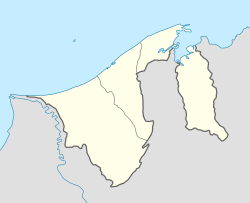History
James Hatton Hall founded the Kumbang Pasang Estate in 1910. [7] Later in 1919, the Labu Estate in Temburong District was superseded as the primary site for rubber planting by the Kumbang Pasang Estate and the Gadong Estate. [8] The majority of the area was utilized for rubber plantations prior to the discovery of oil. By the middle of the 1920s, land for cultivating rubber was in high demand. The government urged residents of Kampong Ayer to relocate to dry ground (such as Kumbang Pasang and Tungkadeh) [9] and start farming. [10] According to a 1924 source, Brunei United Plantations Limited (BUPL) owned four key rubber plantations in Kumbang Pasang, Menglait, Berakas and Melabau. On the morning of 27 April 1933, there was one call for a smoke house fire on the Kumbang Pasang Estate. Before the fire department arrived, the fire was already well under way, yet some of the structure could still be used. [11] The plantation in Kumbang Pasang has a total area of 346 acres (140 ha). In 1953, the BUPL sold the Kumbang Pasang Estate to the Government of Brunei, and the government would establish a rubber nursery a year later. [12]
By 1927, an earth road was made from Brunei Town to Kumbang Pasang Estate. [13] In order to get motor vehicles to BUPL's Kumbang Pasang Estate, a 3 miles (4.8 km) road was built in 1932, [14] later named Jalan Kumbang Pasang. [15] Additionally, the road was one of the first major thoroughfares to be constructed as part of the government's initial RKN (National Development Plan) of 1953–1958. This road superseded an older temporary one constructed in the late 1920s to allow cars to go through to a rubber plantation. It connected to the Berakas and Muara localities and, by the late 1960s, to the Gadong area. [16] Planned for completion by 1957, a road connecting from Kumbang Pasang to the Brunei Airport. [17] 1979 saw the reservation of state land for Kampong Kumbang Pasang's landing stage and slipway site. [18]
Mukim Kumbang Pasang was combined with Mukim Kianggeh for the purposes of the 2001 census. [19] By 2014, the drainage in the village improved as it was previously flood-prone due to its close proximity with the Kedayan River. [20]
This page is based on this
Wikipedia article Text is available under the
CC BY-SA 4.0 license; additional terms may apply.
Images, videos and audio are available under their respective licenses.


